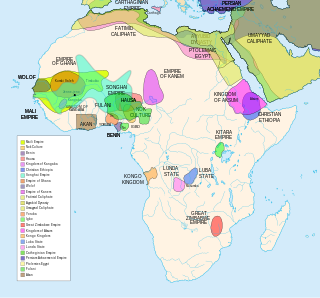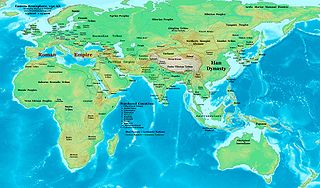Related Research Articles
The Batswana, a term also used to denote all citizens of Botswana, refers to the country's major ethnic group. Prior to European contact, the Batswana lived as herders and farmers under tribal rule.

The British Museum, in the Bloomsbury area of London, United Kingdom, is a public institution dedicated to human history, art and culture. Its permanent collection of some eight million works is among the largest and most comprehensive in existence, having been widely sourced during the era of the British Empire. It documents the story of human culture from its beginnings to the present. It was the first public national museum in the world.

The history of Africa begins with the emergence of hominids, archaic humans and—at least 200,000 years ago—anatomically modern humans, in East Africa, and continues unbroken into the present as a patchwork of diverse and politically developing nation states. The earliest known recorded history arose in Ancient Egypt, and later in Nubia, the Sahel, the Maghreb and the Horn of Africa.
The Hasdingi were the southern tribes of the Vandals, an East Germanic tribe. They lived in areas of today's southern Poland, western Ukraine, Slovakia and Hungary. They participated in the migratory movements of the Vandals into the Iberian peninsula, and subsequently to North Africa.

The 1st century was the century AD 1 to AD 100 according to the Julian calendar. It is often written as the 1st century AD or 1st century CE to distinguish it from the 1st century BC which preceded it. The 1st century is considered part of the Classical era, epoch, or historical period.

The first millennium of the anno Domini or Common Era was a millennium spanning the years 1 to 1000. World population rose more slowly than during the preceding millennium, from about 200 million in the year 1 to about 300 million in the year 1000.

East Africa or Eastern Africa is the eastern region of the African continent, variably defined by geography. In the United Nations Statistics Division scheme of geographic regions, 20 territories make up Eastern Africa:

The Roman provinces were the lands and people outside of Rome itself that were controlled by the Republic and later the Empire. Each province was ruled by a Roman who was appointed as governor. Although different in many ways, they were similar to the states in Australia or the United States, the regions in the United Kingdom or New Zealand, or the prefectures in Japan. Canada refers to some of its territory as provinces.
Bakoena/Bakuena/Bakwena are a large tribe in Southern Africa. They form part of the SeSotho-SeTswana people and can be found in different countries such as Lesotho, Botswana, South Africa, Zimbabwe and Swaziland. Their main languages are Sesotho and Setswana.

The Bantu expansion is a major series of migrations of the original proto-Bantu language speaking group, who spread from an original nucleus around West Africa-Central Africa across much of sub-Saharan Africa. In the process, the Proto-Bantu-speaking settlers displaced or absorbed pre-existing hunter-gatherer and pastoralist groups that they encountered.

Southern Africa is the southernmost region of the African continent, variably defined by geography or geopolitics, and including several countries. The term southern Africa or Southern Africa, generally includes Angola, Botswana, Eswatini, Lesotho, Malawi, Mozambique, Namibia, South Africa, Zambia, and Zimbabwe, though Angola may be included in Central Africa and Malawi, Mozambique, Zambia and Zimbabwe in East Africa. From a political perspective the region is said to be unipolar with South Africa as a first regional power.

The Southern African Customs Union (SACU) is a customs union among five countries of Southern Africa: Botswana, Lesotho, Namibia, South Africa and Eswatini. Its headquarters are in the Namibian capital, Windhoek. It was established in 1910.

The Africanis is a landrace of Southern African dogs. It is believed to be of ancient origin, directly descended from hounds and pariah dogs of ancient Africa, introduced into the Nile Valley from the Levant. Africanis is also an umbrella name for all the aboriginal dogs in Southern Africa.

Africa is the world's second-largest and second-most populous continent. At about 30.3 million km2 including adjacent islands, it covers 6% of Earth's total surface area and 20% of its land area. With 1.3 billion people as of 2018, it accounts for about 16% of the world's human population. The continent is surrounded by the Mediterranean Sea to the north, the Isthmus of Suez and the Red Sea to the northeast, the Indian Ocean to the southeast and the Atlantic Ocean to the west. The continent includes Madagascar and various archipelagos. It contains 54 fully recognised sovereign states (countries), four territories and two de facto independent states with limited or no recognition. The majority of the continent and its countries are in the Northern Hemisphere, with a substantial portion and number of countries in the Southern Hemisphere.

The Mthethwa Paramountcy, sometimes referred to as the Mtetwa or Mthethwa Empire, was a Southern African state that arose in the 18th century south of Delagoa Bay and inland in eastern southern Africa. "Mthethwa" means "the one who rules". According to Muzi Mthethwa (1995), the Mthethwas are descended from the Nguni tribes of northern Natal and the Lubombo Mountains, whose modern identity dates back some 700 years. They are among the first Thonga-Nguni groups who left the Great Lakes in Central Africa between 200 AD and 1200 AD. On arrival in Southern Africa, they settled around modern-day Swaziland, mainly on the Lubombo Mountains, before leaving in the 17th century to settle in modern-day KwaZulu-Natal, in the Nkandla region. It consisted of roughly 30 Nguni Chiefdoms, lineages, and clans. Unlike its successor, the Zulu Kingdom, the Mthethwa Paramountcy was a confederation. After Zulu prince Sigidi kaSenzagakhona became king, he forged a nearly homogeneous nation with a single king (nkosi).
"Tar Baby" was the name given by the United States State Department to Richard Nixon's policy during the late 1960s and 1970s of strengthening contacts with the white-minority governments in southern Africa — Portugal, Rhodesia and apartheid-era South Africa. The allusion was to the Uncle Remus story in which Brer Fox tries to capture Brer Rabbit by making a tar baby. Brer Rabbit strikes the tar "baby" with his hands, feet, and head and eventually becomes completely adhered to it. The policy option, described as a partial relaxation of economic action against Rhodesia, South Africa and Portugal, and derived from NSSM: 39, was based on the presumption that apartheid and colonial rule were an unpleasant but undeniable reality and that Washington should accommodate itself pragmatically to the status quo. According to Nixon, if the United States was to be an influence for enlightened change it must do so by offering the "carrot" and eschewing the "stick". This policy would have to be pursued ad infinitum to get it to work.

A partial solar eclipse took place on Monday, 19 April 2004. A solar eclipse occurs when the Moon passes between Earth and the Sun, thereby totally or partly obscuring the image of the Sun for a viewer on Earth. A partial solar eclipse occurs in the polar regions of the Earth when the center of the Moon's shadow misses the Earth. It was largely visible over the south Atlantic Ocean and north shores of Antarctica, most prominently the Antarctic Peninsula. The eclipse was deep enough to be seen from a large portion of southern Africa, with over 50% totality at Cape Town, South Africa at approximately 4:10 PM. However, the eclipse remained visible to cities such as Harare, Maseru, Durban, and Bloemfontein, although to a much lesser extent.

The Kingdom of Aksum, also known as the Kingdom of Axum or the Aksumite Empire, was an ancient kingdom centered in what is now Eritrea and the Tigray Region of northern Ethiopia. Axumite Emperors were powerful sovereigns, styling themselves King of kings, king of Aksum, Himyar, Raydan, Saba, Salhen, Tsiyamo, Beja and of Kush. Ruled by the Aksumites, it existed from approximately 80 BC to AD 825. The polity was centered in the city of Axum and grew from the proto-Aksumite Iron Age period around the 4th century BC to achieve prominence by the 1st century AD. Aksum became a major player on the commercial route between the Roman Empire and Ancient India. The Aksumite rulers facilitated trade by minting their own Aksumite currency, with the state establishing its hegemony over the declining Kingdom of Kush. It also regularly entered the politics of the kingdoms on the Arabian Peninsula and eventually extended its rule over the region with the conquest of the Himyarite Kingdom. The Manichaei prophet Mani regarded Axum as one of the four great powers of his time, the others being Persia, Rome, and China.

Bantu are the speakers of Ntu languages, comprising several hundred indigenous ethnic groups in sub-Saharan Africa, spread over a vast area from Central Africa across the African Great Lakes to Southern Africa. Linguistically, these languages belong to the Southern Bantoid branch of Benue–Congo, one of the language families grouped within the Niger–Congo phylum.
The climate of ancient Rome varied throughout the existence of that civilization. In the first half of the 1st millennium BC the climate of Italy was more humid and cool than now and the presently arid south saw more precipitation. The northern regions were situated in the temperate climate zone, while the rest of Italy was in the subtropics, having a warm and mild climate. During the annual melt of the mountain snow even small rivers would overflow, swamping the terrain. The existence of Roman civilization spanned three climatological periods: Early Subatlantic, Mid-Subatlantic (175–750) and Late Subatlantic.